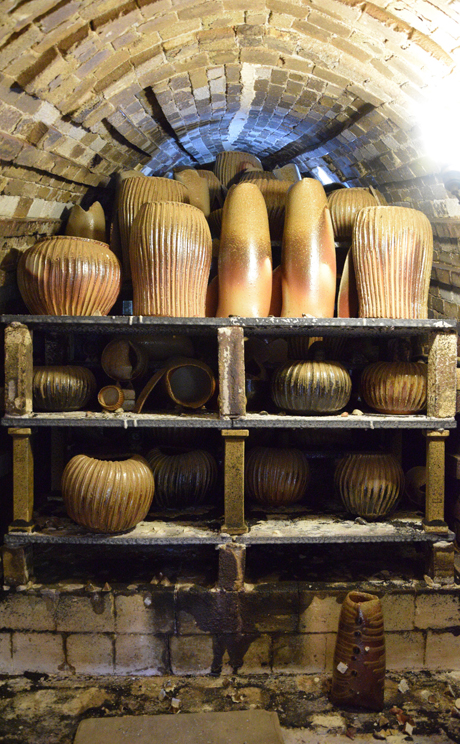Navigation auf uzh.ch
Navigation auf uzh.ch
Traditional Japanese ceramics enjoy an outstanding reputation for their refined aesthetics. The production process requires a profound knowledge, but also the so-called “workmanship of risk” to obtain the well-known decorative patterns.
Nathalie Marseglia
It’s 8 a.m. on Thursday November 19th. I’m sitting in a cozy café at Imbe Station, slowly sipping my morning coffee out of a Bizen-yaki style cup. Two days of heavy rain have passed since my last visit to Imbe, a small pottery village located in a sheltered river valley in the Bizen area of the Okayama prefecture. Among both the Japanese and Western aficionados of Japanese ceramics, the region is well known for its natural ash-glazed stoneware called Bizen-yaki.

Although the roots of Bizen pottery production date back to around the 4th century CE, the Momoyama period (1573–1603) is commonly considered the heyday of Bizen pottery making. This was when the characteristic appearance of yakishime ceramics (high fired unglazed stoneware) was prized and patronized by leading tea masters. But during the Meiji period (1868–1912), the increasing export market for porcelain wares, along with new modes of production initiated by the Industrial Revolution, made it hard for Bizen potters to make a living with pottery alone, prompting them to take up production of industrial ceramics like sewer pipes and refractory bricks. It was not until the 1930s that the lost ancient techniques and styles of Bizen pottery were revived by Kaneshige Tōyō (1896–1967). In 1956, honored for his efforts, he became the first Living National Treasure (officially: Holder of an Important Intangible Cultural Property) for Bizen-yaki. Since then Japanese society has undergone great changes, and Japanese ceramics have became a field of blurred lines. So the question of why, what and how to preserve, seems much more challenging today than in the days when the Law for the Protection of Cultural Properties (1950) was passed. A closer look at the kiln of the present-day holder of Bizen-yaki, Isezaki Jun (born 1936), might provide some insight into the craft practices that are meant to be safeguarded by the Living National Treasures program.
It is almost 9 o’clock and I am awaiting Akane, Isezaki Kōichirō’s wife, to come in any second and pick me up. Today is kama-dashi—the kiln opening—at the Isezaki studio. After over two weeks of firing and cooling down, this is the moment when months of skilled labor is finally unveiled. This photo was taken right after Isezaki Kōichirō (the son of Isezaki Jun and himself a renowned ceramic artist) removed the bricks from the plastered front hole of the kiln with the assistance of the sensei’s three deshi (apprentices). The heat inside is overwhelming and reminds me of a Finnish sauna (the back of the kiln still measures 70° C). Under normal circumstances, they would not open the kiln while the temperature was still so high, but a Japanese film crew was also present, so the day of the opening had to be fixed in advance.

The picture shows the first row of pieces or, to be more precise, the pieces that were placed at the very end of the loading. It is a common yet overly romanticized view held by many Western admirers of Bizen-yaki (or of yakishime ceramic ware in general) that the various decorative patterns, such as the sprinkled sesame seed-like pattern (goma) visible on the shoulder parts of the pots and vases on the topmost shelf, occur purely accidentally. Although the flames and the swirling ashes may play a part, the patterns are much more the result of what David Pye (1968) has called the workmanship of risk; [1] the skilled craftsmen who depend on their experience and knowledge in an environment where the quality of the result is constantly at risk. Taking another look at the picture, we see that the workmanship of risk involves knowing how to position each of the roughly 400 hundred pieces in this 10 meter anagama (single-chamber) tunnel kiln, while carefully considering the directions and intensity of the flames during the different stages of firing.
Without a profound understanding of the relevant craft practices and techniques, it is hard to grasp the knowledge of skilled craftsmen. What happens, though, when the valuation of craft knowledge becomes institutionalized, as is the case with the Living National Treasures program? Three months of fieldwork in Japan have shown that this question has to be seen in light of cultural heritage politics, art institutions, social networks as well as the craftsmen at work.
[1] Pye, David. The Nature and Art of Workmanship. Cambridge: Cambridge University Press, 1968.
(Asia & Europe Bulletin, 5/2016, pp. 35–36)